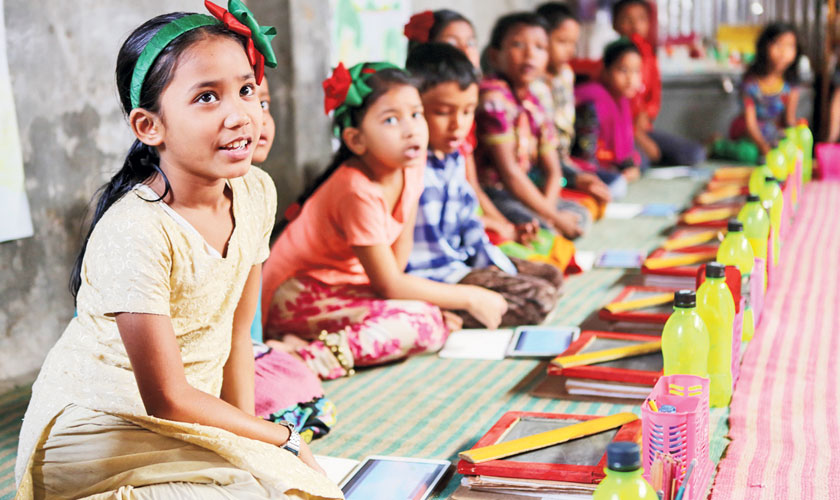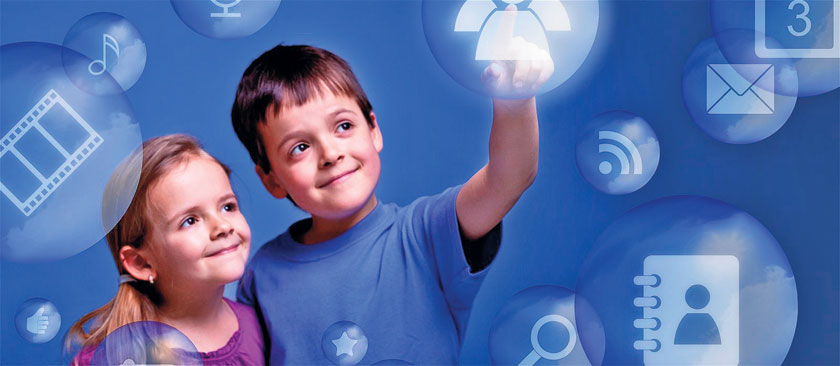Literacy is an essential skill and with technology changing the way people think, it is time to spread education through digital means. You! takes a look...
Literacy is an essential skill and with technology changing the way people think, it is time to spread education through digital means. You! takes a look...
At record speed, digital technologies are fundamentally changing the way people live, work, learn and socialise everywhere. They are giving new possibilities to people to improve all areas of their lives including access to information; knowledge management; networking; social services; industrial production, and mode of work. However, those who lack access to digital technologies and the knowledge, skills and competencies required to navigate them, can end up marginalised in increasingly digitally driven societies. Literacy is one such essential skill.
So what does it mean to be literate? In order to close the literacy skills gap and reduce inequalities, this year’s International Literacy Day (TILD), annually observed on September 8, highlights the challenges and opportunities in promoting ‘Literacy in a Digital World’. The main aim is to focus on basic literacy skills and promote digital learning all around the world.

This year marked the 51st anniversary of The International Literacy Day. On 7 and 8 September, 2017 a special two-day event was organized at UNESCO’s Headquarters in Paris, with the overall aim to look at what kind of literacy skills people need to navigate increasingly digitally-mediated societies, and to explore effective literacy policies and programmes that can leverage the opportunities that the digital world provides.
UNESCO made the decision to observe The International Literacy Day in the year 1965. However, it was in 1966 that this Day was officially celebrated on 8th of September all around the globe. It is an occasion to mark achievements and reflect on ways to counter remaining challenges for the promotion of literacy as an integral part of lifelong learning.
Statistics show...
According to Economic Survey of Pakistan (2016-2017), the country’s literacy rate has declined from 60 per cent to 58 per cent. The survey also shows that literacy rate remains much higher in urban areas, 74 per cent, (male, 81 per cent and female, 68 per cent) than in rural areas, 49 percent. Province wise data suggests that Punjab and Sindh lead with 62 per cent and 55 per cent respectively followed by Khyber Pakhtunkhwa with 53 per cent and Balochistan with 41 per cent.
Digitalization in Pakistan
Even though, the overall stats are a little disappointing, it is quite heartening to see that many urban schools, including technical institutes, have started to reshape their curriculum by inducing computer-based examination system as they intend to give them competency skill sets rather than just technical skills. Indeed, digital technology is becoming the central axis, rapidly redefining the way we live and work and e-education is the need of the hour. Web Based education not only strengthens a student’s learning experience but allows him/her to be more innovative and creative.
Inclusion of digital learning in remote areas
Although Pakistanis are officially reported to have 58% literacy rate but even those who are called as ‘Literate’ are only able to read and write, which in today’s skill oriented world is static and hence considered as illiteracy. And now, the evolution of digitalization has made literacy almost an alien concept in our part of the world, especially in underprivileged areas. The question that arises here is, how can digital learning be included in the curriculum when there is a decline in the overall literacy rate? It seems like a farfetched idea, especially in the rural areas where there is a lack of healthcare facilities, access to sanitation and clean water etc.
However, there are some NGOs who are trying to make the situation better by introducing ways of digital learning and using Informational and Communication Technologies (ICTs) in various remote and low income areas. And with trial and error, they have been successful in introducing digital learning. Here are a few initiatives that are being carried out to make children acquire digital learning and compete in the fast paced digital world...
Ilm on Wheels
Ilm on Wheels aims to enhance learning achievements in mathematics for public primary school children in the remote areas of Khyber Pakhtunkhwa Province. They are providing access to online learning content and tools via a satellite-enabled Mobile Van.
Digital Study Hall (DiSH)
Another initiative that is also being carried out in Khyber Pakhtunkhwa is the DiSH project. They use interactive video lessons to deliver quality lessons in public primary schools and simultaneously are training teachers to improve pedagogy and teaching practices.
3D Conceptual Learning through CAD
In underprivileged areas of Rawalpindi, 3D Computer Aided Design (CAD) courses have been introduced at the secondary school level. Their aim is to enhance conceptual understanding of science subjects and vocational skills of students.
Digital Means
Digital Means is developing web based e-learning content based on the local government curriculum for English and Mathematics, for grades 4 and 5. This content will be piloted at schools in Punjab to assess its effectiveness in improving student learning achievements.
Britannica Learning Tools
Britannica Learning Tools aims to improve the learning outcomes in mathematics of under-privileged students in Lahore, through the provision of an e-learning tool called Smart Math.
Situation in the metropolis
Although schools and educational institutes in cities have been trying to induce technological learning among students but the curriculum still incorporates traditional means of education i.e. through books and manuals. Principal O’ Level of Dawood Public School (DPS) in Karachi, Mahvash Roshani, while talking to You! comments on how much digitalization is necessary for the current age and how the school is providing digital help to the students’ learning. “Provision of education through digital means is the need of time. World has become a global village and that time is not far when schools will be taking online exams. We also need to match the footsteps and let our children acquire modern ways of learning and attaining knowledge,” she says.
“Our children haven’t been asked yet to bring digital tablets in the class, but we are thinking to let them bring the gadget in their fine art classes. We have computers in libraries where children from primary to secondary level come and carry out their research works. We have CDs provided with the O Levels books from which children solve problems. Furthermore, our teachers are given online training that would help students learn new ways and skills from their teachers. We have integrated subjects and give authentic website links in the curriculum so that children might do search for topics online as well in order to develop this basic literacy skill,” she states.
Another teacher is of the same view. Sabah Saeed, a senior grade teacher at City School, Karachi, talks about the importance of digitalization in children’s education, and using it as an effective tool for literacy. “Literacy has always been plan A, if you are not literate, you won’t have the sense of understanding things. You will neither become able to develop any skill and hence you will not be having any talent or a power to learn and analyze. But when we bring literacy in a digital world, it becomes a broader idea. It is not just considered as a way of acquiring knowledge or a skill, but also it defines what is right and wrong. Morality, values and ethics, which were taught to children or made them write in sentences on a paper, have been now practiced by them practically because of digitalization. Education is no more a theory. It’s a complete practical concept which children now implement in their lives and also find solutions about it.”
“As far as the point that how much we are incorporating digital learning in the curriculum is concerned, then I must mention that yes, but a little bit. You can name it as e-learning or hands on experience. Just to tell the students to go search on their own brings them confidence that for a change, they don’t have to rely on their teacher. They can find solutions and learn by themselves also. Now, computer systems are not just used for the computer subject. They are used for every other subject. But we are slowly inducing such practices as we haven’t been able to come out of the ‘book culture’ because it is very difficult to do it. We have worked really hard to make children learn the importance of reading books and using them as a learning tool. So if now we will shift them to e-learning and make them interact with the technology immediately, it will be disturbing for them. This process should be done in a channelized manner. Once you allow them to sit with a tablet or a laptop, they might get distracted and it will become equal to using Facebook, Instagram and Snapchat which obviously we don’t want. So to promote digital means of education, there should be thorough home work on the end of the teachers or education institutes,” she adds.
Saeed elaborates that digital learning in today’s world has become vital. Teachers don’t involve children in digital learning much today but they should do. However, there must be effective ways to do it.
Digital Strategy in the West

The 21st century has been rightly termed as the digital era. With internet bringing a substantial change in peoples’ lives we are heavily dependent on the usage of technology to even complete simple tasks. But what is digital learning? It can be defined as a web based learning which effectively makes use of the information technology to impart knowledge to the students. In the west, this method of teaching has been introduced only a few years ago and has got a tremendous response from all over the world. In other words, it is also known as the Smart Teaching Technique and as such most of the schools and educational institutions have gladly adopted this method thereby bringing a colossal change in the educational system. The kids are taught with the help of large LCD screens and projectors which is beyond the conventional methods of teaching. It facilitates learning process anywhere and anytime. The teacher now does not have to take the pains of writing on the blackboard with white chalks and then erase it afterwards.
Beyond any doubt, the digital learning procedure has made research work simpler. With information easily available on the internet you can find solution to any problem or question and carry your work further. Moreover, there is freedom to choose the place and there is no restriction of time. There is no need to compete with the rest of the class as e-learning allows you to learn at your own pace. Digital learning technologies not only enable students to grasp concepts more quickly and fully but allow them to connect theory and application more adeptly.